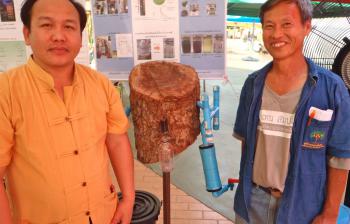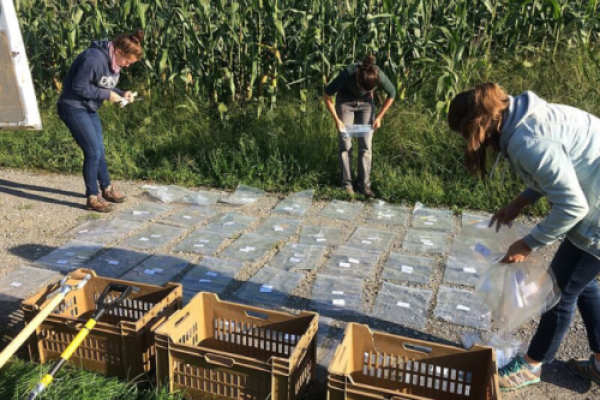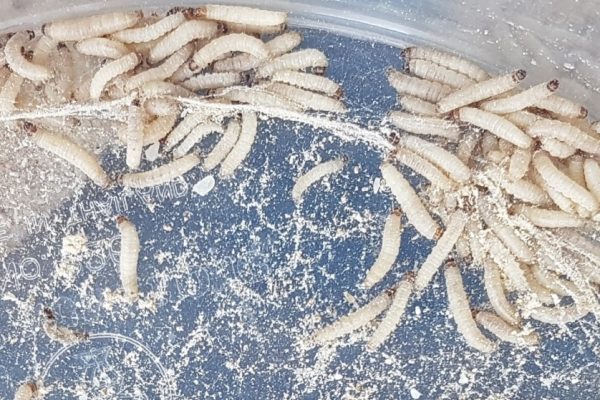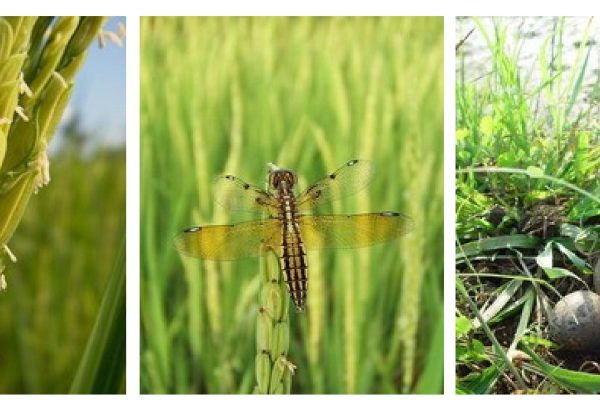
As part of the Wanakaset network, one of the trees we promote and plant in our agroforestry systems, is Dipterocarpus alatus, known as the queen of the Thai forest. These trees shoot to the top of the canopy and can live over 700 years. Their Thai name “Yang Na” is a composite of 2 words “Yang” meaning resin or rubber and “Na” meaning ricefields. This tree was commonly found in and around ricefields. It is well adapted to handle periodic flooding and according to Sri Lankan tradition, as recounted by organic activist, Mr. Ajanta, this tree was regarded as important for maintaining rice field soil fertility. It has a tight canopy that casts very little shade and a deep root system that does not compete with rice roots while doing a good job of collecting nutrients washing down into the earth. As it loses most of its leaves during the dry season, these nutrients are then placed back on the soil ready for the rice plants to use in their time.
All of the dipterocarpus have “Yang” or resin, some species having large quantities of resinous oil. The high hydrocarbon resin of Dipterocarpus alatus, has been harvested since long ago in Thai and probably pre-Thai history to be used for torches and to seal boats watertight.
Since I became aware of the large quantities of resinous fuel that can be tapped from these trees once they are mature, I thought that it must be possible to use this resin to power engines and vehicles. Aside from this, the traditional way of tapping the trees seemed quite brutal. (A huge gash is cut out of the tree and fire is used to keep the resin flowing which is then captured.) I understood this was the same technique used for hundreds of years and I believed there must be an easier and more efficient way. Not knowing these answers was not reason for us not to plant many Yang Na trees. They offer many other benefits (see my recent essay “How to propagate mycorrhizal mushrooms in your forest / garden” for yet another good reason). There is some discussion in the permaculture world of “When is the best time to plant trees?” The answer is 10 or 20 years ago. But the second best time is today. We are doing pretty well with many trees planted 2, 3, 4, 5 and some close to 10 years old.
While at the Golden Jubilee Agriculture Museum with my wife selling our network’s products, just about 20 meters away I could hear a presentation going, “How to produce diesel from Yang Na trees” I just had time to catch the very end of this but then saw the presenter had a booth outside. There I had time to talk with Dr. Somporn Katekaew and his assistant, Mr. Arnon Ngo-Son, both of Khon Khan University.
They had been doing research and succeeded in both of the ideas I had conceived of years back. They had developed better ways to tap the trees using drills and pipes without a need to burn the trees. They also found out two ways to produce diesel from the resin: one by distillation and the other chemically. Dr. Somporn said that mature trees (normally at 20 years) can produce 400 ml of resin per day with is 70 +% oil (very high in hydrocarbons). With distillation the oil is separated from the sticky resin. This oil can be used directly in farm equipment engines. They said it does have a rather high ignition point so it might be difficult to start with on a cold engine. They intend to test further with diesel automobile engines. They said that distillation yields a cleaner/ purer product than chemical separation.

Traditional Tapping Method(left) Innovation(Right)

While these two developments seem like a great accomplishment, it was clear that there is still farther to go. They have only tested this on a micro scale producing just a few liters of product. I was considering if we are to produce enough diesel to supply our pickup truck, what would we need. I figure about 1000 liters per year would meet our current use. This is about 3 liters per day. At 400 ml resin per tree per day of which 70% is diesel, we need 11 productive trees to produce enough for our truck. 4400 ml x 70% = 3.080 litres. This is definitely a manageable number as we have more than this number of yang na trees growing. However then there is a second question about the cost of processing. I believe Dr. Somporn and those working with him may find easier ways to distill the resin, but now they require distillation using a vacuum as well to separate the liquid without risk of ignition. This and the small scale at present would make distillation unattractive in terms of net energy gain.
My thought, that I proposed to the Khon Khan University team is to develop this into a community enterprise. Wanakaset network could be one such enterprise operator as most all of our members are growing Dipterocarpus alatus in our agroforestry systems. Where now we use earnings from our savings group to pay for the fuel cost of members to join the monthly meetings, we could all bring our resin with us to distill together and fuel up for the return. I think a system that could distill about 1000 liters at a time might be practical for our purposes. We might even develop function stacking, using waste heat from charcoal or biochar production to fuel the distillation. I know other communities that have Yang Na groves that also could start such community enterprises. I think with good management, we could process our resin, fill up with the biodiesel yield, while collectively selling the resin for other purposes to cover equipment and other costs and develop group strength.
As fuel costs increase this should become more and more interesting. As this process is developed and more of our members and others have productive Yang Na trees in their farming systems, the scale of production can be increased, with farmers being able to exchange Yang Na resin for biodiesel at local distilleries. While I believe the whole world needs to reduce energy use, it would be easy and of many benefits for every small-scale Thai farmer to grow 10 Yang Na trees. Produced, distilled and used locally, there would be very low transportation costs, while the benefits of this could be going directly to the community.
I am very happy that Dr. Somporn and his team are doing this work and sharing their knowledge to promote self-sufficiency. They are an example of human ingenuity working with local sustainable resources to find solutions to our problems. Helping make my dream a reality, the threat of peak oil no longer seems like such a threat, maybe it is just an opportunity for us to restore trees in our landscape, to provide mushrooms, woods, shade, biodiesel and resin. Before I thought that while today I am spending about 1 USD per liter of diesel that in 20 years I might be spending $3 USD per liter. Now it looks like in 20 years I may be spending nothing on diesel and my diesel source could be having a net carbon sequestration value building majestic trees that will be providing fuel, mushrooms, shade, soil nutrients, and other values for centuries into the future.
By Michael B. Commons, Earth Net Foundation, Thailand



